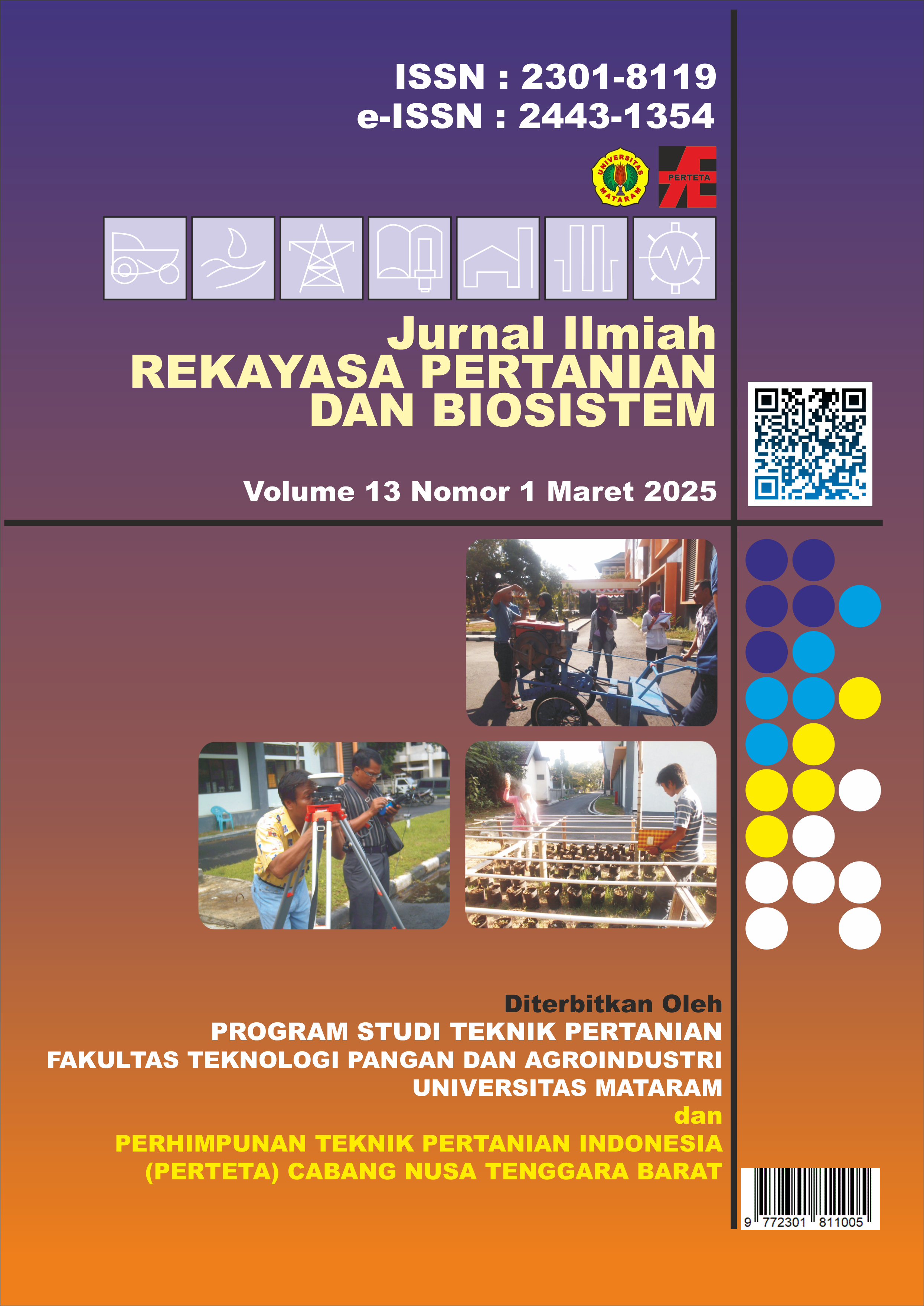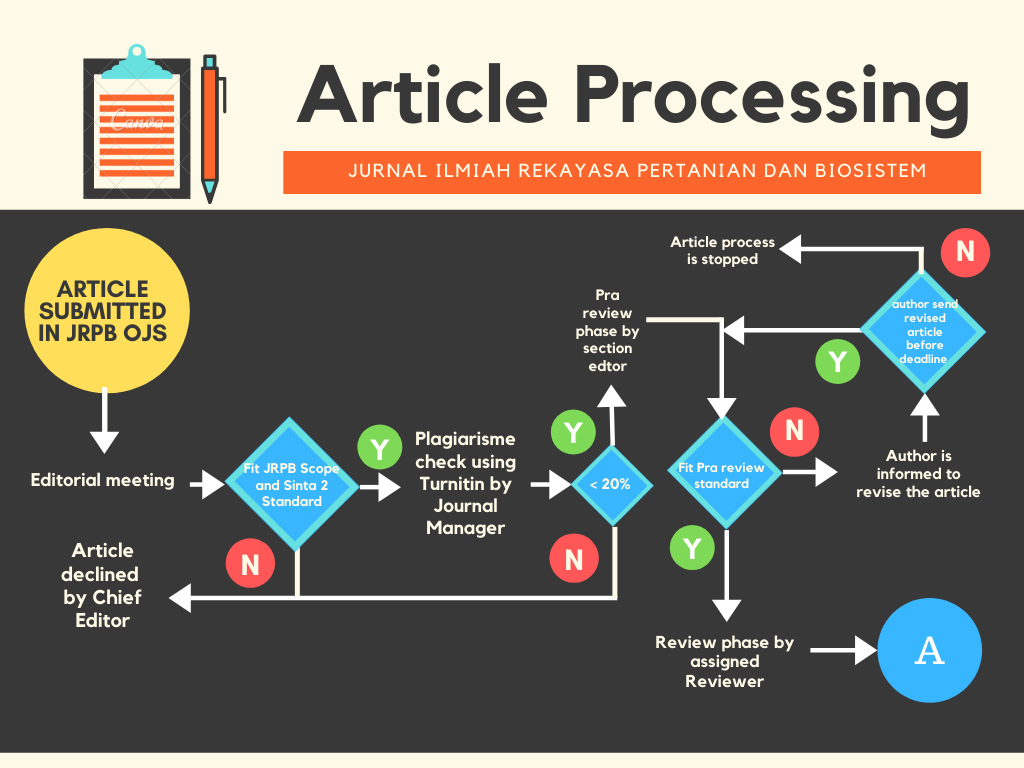Low-Cost Monitoring and Control for Melon Cultivation in Greenhouse using Internet of Thing and Drip Irrigation
Authors
Supriyanto , Rafli Arya Fahrezi , Tegar Adi Prasetyo , Ananda Putra Septiadi , Lilis Sucahyo , Mohamad SolahudinDOI:
10.29303/jrpb.v13i1.1154Published:
2025-03-27Issue:
Vol. 13 No. 1 (2025): Jurnal Ilmiah Rekayasa Pertanian dan BiosistemKeywords:
control, drip irrigation, internet of thing, melon production, monitoring systemArticles
Downloads
How to Cite
Downloads
Abstract
Melons are become a popular fruit cultivating inside the greenhouse using the drip irrigations in Indonesia. The application of internet of things-based monitoring is beneficial to optimize cultivation management. Another issue on melon cultivation inside the greenhouse is automation of the water and nutrient delivery. However, currently monitoring and control is expensive and difficult to modify by farmers. The aim of this study was to develop a low-cost technology and easy to use by farmers using internet of technology. The method used in this study consisted of analysis, design and implementation. The result of this study was a system monitoring to monitor air temperature, air humidity, media humidity and solar radiation inside the greenhouse integrated with nutrient or water delivery using drip irrigation. A web-based dashboard was developed as a user interface for the farmers and users. The overall cost to develop a system monitoring and control was 358.24 USD not including the water thank and nutrient delivery system (pump and irrigations pipe). The system was deployed and tested at Agribusiness and technology park IPB University.
References
Azaza, M., Tanougast, C., Fabrizio, E., & Mami, A. (2016). Smart greenhouse fuzzy logic based control system enhanced with wireless data monitoring. ISA Transactions, 61, 297–307. https://doi.org/10.1016/j.isatra.2015.12.006 DOI: https://doi.org/10.1016/j.isatra.2015.12.006
Bao, L., Zhang, S., Liang, X., Wang, P., Guo, Y., Sun, Q., Zhou, J., & Chen, Z. (2023). Intelligent drip fertigation increases water and nutrient use efficiency of watermelon in greenhouse without compromising the yield. Agricultural Water Management, 282. https://doi.org/10.1016/j.agwat.2023.108278 DOI: https://doi.org/10.1016/j.agwat.2023.108278
Bersani, C., Ruggiero, C., Sacile, R., Soussi, A., & Zero, E. (2022). Internet of Things Approaches for Monitoring and Control of Smart Greenhouses in Industry 4.0. Energies, 15(10). https://doi.org/10.3390/en15103834 DOI: https://doi.org/10.3390/en15103834
Chen, R., Wang, Z., Liu, W., Ding, Y., Zhang, Q., & Wang, S. (2023). Side Lighting of Red, Blue and Green Spectral Combinations Altered the Growth, Yield and Quality of Lettuce (Lactuca sativa L. cv. “Yidali”) in Plant Factory. Plants, 12(24). https://doi.org/10.3390/plants12244147 DOI: https://doi.org/10.3390/plants12244147
Erniati, E., Suhardiyanto, H., Hasbullah, R., & Supriyanto, S. (2023). Artificial Neural Networks to Predict Melon (cucumis melo L.) Production in Tropical Greenhouse, Indonesia. Jurnal Keteknikan Pertanian, 11(2), 193–204. https://doi.org/10.19028/jtep.011.2.193-204 DOI: https://doi.org/10.19028/jtep.011.2.193-204
Erniati, Suhardiyanto, H., Hasbullah, R., & Supriyanto. (2024). Photosynthetic Rate Prediction Model of Golden Melon Plant (Cucumis melo L.) at Vegetative Phase in Greenhouse using Artificial Neural Networks. HAYATI Journal of Biosciences, 31(1), 30–38. https://doi.org/10.4308/hjb.31.1.30-38 DOI: https://doi.org/10.4308/hjb.31.1.30-38
Hosny, K. M., El-Hady, W. M., & Samy, F. M. (2024). Technologies, Protocols, and applications of Internet of Things in greenhouse Farming: A survey of recent advances. Information Processing in Agriculture, March. https://doi.org/10.1016/j.inpa.2024.04.002 DOI: https://doi.org/10.1016/j.inpa.2024.04.002
Koukounaras, A. (2021). Advanced greenhouse horticulture: New technologies and cultivation practices. Horticulturae, 7(1), 1–5. https://doi.org/10.3390/horticulturae7010001 DOI: https://doi.org/10.3390/horticulturae7010001
Li, X., Hu, X., Song, S., & Sun, D. (2022). Greenhouse Management for Better Vegetable Quality, Higher Nutrient Use Efficiency, and Healthier Soil. Horticulturae 2022, Vol. 8, Page 1192, 8(12), 1192. https://doi.org/10.3390/HORTICULTURAE8121192 DOI: https://doi.org/10.3390/horticulturae8121192
Lin, N., Wang, X., Zhang, Y., Hu, X., & Ruan, J. (2020). Fertigation management for sustainable precision agriculture based on Internet of Things. Journal of Cleaner Production, 277, 124119. https://doi.org/10.1016/j.jclepro.2020.124119 DOI: https://doi.org/10.1016/j.jclepro.2020.124119
Mondejar, M. E., Avtar, R., Diaz, H. L. B., Dubey, R. K., Esteban, J., Gómez-Morales, A., Hallam, B., Mbungu, N. T., Okolo, C. C., Prasad, K. A., She, Q., & Garcia-Segura, S. (2021). Digitalization to achieve sustainable development goals: Steps towards a Smart Green Planet. Science of The Total Environment, 794, 148539. https://doi.org/10.1016/J.SCITOTENV.2021.148539 DOI: https://doi.org/10.1016/j.scitotenv.2021.148539
Naounoulis, I., Faliagka, S., Levizou, E., & Katsoulas, N. (2024). Cascade hydroponics enhanced water and nutrients use efficiency in a greenhouse cucumber-melon crop combination. Scientia Horticulturae, 338(May), 113822. https://doi.org/10.1016/j.scienta.2024.113822 DOI: https://doi.org/10.1016/j.scienta.2024.113822
Prastono, H., Solahudin, M., & Hortikultura, R. (2024). Sistem Kendali Fertigasi Presisi Berbasis Logika Fuzzy untuk Budidaya Tanaman Hidroponik. 12(2), 294–313. https://doi.org/10.29303/jrpb.v12i2.639 DOI: https://doi.org/10.29303/jrpb.v12i2.639
Rayhana, R., Xiao, G., & Liu, Z. (2020). Internet of Things Empowered Smart Greenhouse Farming. IEEE Journal of Radio Frequency Identification, 4(3), 195–211. https://doi.org/10.1109/JRFID.2020.2984391 DOI: https://doi.org/10.1109/JRFID.2020.2984391
Salih, J. E. M., Adom, A. H., & Shaakaf, A. Y. Md. (2012). Solar Powered Automated Fertigation Control System for Cucumis Melo L. Cultivation in Green House. APCBEE Procedia, 4, 79–87. https://doi.org/10.1016/J.APCBEE.2012.11.014 DOI: https://doi.org/10.1016/j.apcbee.2012.11.014
Sharma, S. P., Leskovar, D. I., Crosby, K. M., Volder, A., & Ibrahim, A. M. H. (2014). Root growth, yield, and fruit quality responses of reticulatus and inodorus melons (Cucumis melo L.) to deficit subsurface drip irrigation. Agricultural Water Management, 136, 75–85. https://doi.org/10.1016/j.agwat.2014.01.008 DOI: https://doi.org/10.1016/j.agwat.2014.01.008
Subahi, A. F., & Bouazza, K. E. (2020). An Intelligent IoT-Based System Design for Controlling and Monitoring Greenhouse Temperature. IEEE Access, 8, 125488–125500. https://doi.org/10.1109/ACCESS.2020.3007955 DOI: https://doi.org/10.1109/ACCESS.2020.3007955
Suppen-Reynaga, N., Guerrero, A. B., Dominguez, E. R., Sacayón, E., & Solano, A. (2024). Life cycle assessment of bananas, melons, and watermelons from Costa Rica. Cleaner and Circular Bioeconomy, 9(November 2023). https://doi.org/10.1016/j.clcb.2024.100120 DOI: https://doi.org/10.1016/j.clcb.2024.100120
van Klompenburg, T., Kassahun, A., & Catal, C. (2020). Crop yield prediction using machine learning: A systematic literature review. In Computers and Electronics in Agriculture (Vol. 177). Elsevier B.V. https://doi.org/10.1016/j.compag.2020.105709 DOI: https://doi.org/10.1016/j.compag.2020.105709
Wang, J., Niu, W., Dyck, M., Zhang, M., & Li, Y. (2018). Drip irrigation with film covering improves soil enzymes and muskmelon growth in the greenhouse. Soil Research, 56(1), 59–70. https://doi.org/10.1071/SR17036 DOI: https://doi.org/10.1071/SR17036
License
Copyright (c) 2025 Supriyanto, Rafli Arya Fahrezi, Tegar Adi Prasetyo, Ananda Putra Septiadi, Lilis Sucahyo, Mohamad Solahudin

This work is licensed under a Creative Commons Attribution-ShareAlike 4.0 International License.
Authors who publish with this journal agree to the following terms:
- Authors retain copyright and grant the journal right of first publication with the work simultaneously licensed under a Creative Commons Attribution License 4.0 International License (CC-BY-SA License). This license allows authors to use all articles, data sets, graphics, and appendices in data mining applications, search engines, web sites, blogs, and other platforms by providing an appropriate reference. The journal allows the author(s) to hold the copyright without restrictions and will retain publishing rights without restrictions.
- Authors are able to enter into separate, additional contractual arrangements for the non-exclusive distribution of the journal's published version of the work (e.g., post it to an institutional repository or publish it in a book), with an acknowledgement of its initial publication in Jurnal Ilmiah Rekayasa Pertanian dan Biosistem (JRPB).
- Authors are permitted and encouraged to post their work online (e.g., in institutional repositories or on their website) prior to and during the submission process, as it can lead to productive exchanges, as well as earlier and greater citation of published work (See The Effect of Open Access).










